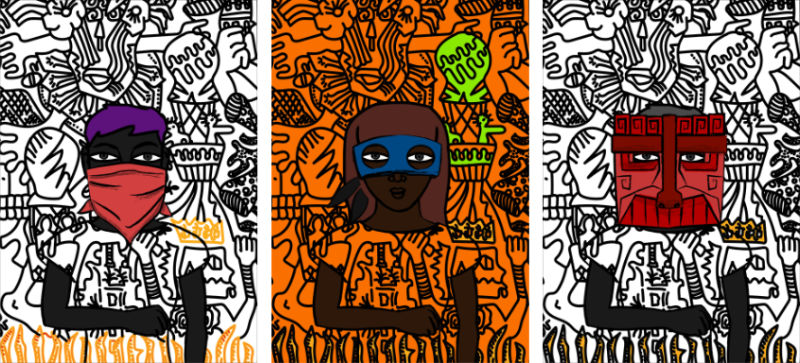Blog / 2021 / The Memory Card Game (But for Art)
March 2, 2021
A field of cards all laid out face down in a grid, ready for play. You turn over one card at random and then another. If the images on the cards don’t match, you return them to their starting position, and it’s someone else’s try. Eventually, you get to a point where you’ve seen where at least half of each pair lives, and it’s a question of turning them over together.
Memory card games were always fun for me. I used to think it had to do with me being a visual person, but now I believe it’s something more, because I never stopped playing the game.

These days, I’ve left the cards behind and I play instead with art, like when people are inspired by my paintings.

Note the detail of the arrows in my portrait showing up Adrienne Lewis’ work. Whenever someone uses my art to make their own, I’m fascinated to find all the little ways my work bleeds into theirs.

But my art memory game goes much further. I’m always connecting the work of artists I admire, like with Joi Murugavell and Tenya Rodriguez, for example, because of their graphic styles and the way they layer imagery to build up a narrative.

Sometimes the pairing is less obvious, like with these two. Still, every time I see Michaela Oteri’s work, I can’t help but think of Riva Lehrer’s because of their shared interest in fantasty, figures, and disability rights.

As these two very different but also very similar images by Emma Larsson and Libby Fife demonstrate, the art memory game isn’t about finding exact matches, of course. It’s just the enjoyment of making connections and figuring out the puzzle of my own personal art memory card deck.

I’m pretty sure this same appeal is driving the popularity of Hashmasks, a tech-heavy art project with sales reaching into the hundreds of thousands, whose two creators are choosing to remain anonymous.
These two nameless artists hired seventy more to make digital imagery of masks, backgrounds, and items. Then the two original “artists of artists,” as they call themselves, assembled these elements into Hashmasks like those shown here. In all, there are 16384 individual Hashmasks, with 20% being assembled by hand by the two artists of artists and the remaining 80% by an algorithm.

Once the images were put together, the artists of artists then assigned each digital artwork a certificate of ownership/authenticity called a non-fungible token. It’s these NFTs that are being bought and resold for really big sums of money, mostly by people who understand blockchain like I understand the complex properties of different kinds of acrylic paints. (In other words, do us all a favor: don’t ask them about the personalities of particular pigments and don’t ask me to explain the value of NFTs further!)
With the NFT comes the right to title the piece and, eventually, to retitle it as well. But, though the buyers’ naming rights are being touted as one of the more creative parts of this project, so far the actual titles are, on the whole, not exactly scintillating. You can see what’s been assigned by clicking through the gallery on the Hashmasks site.

The other big win for Hashmasks is supposedly the way it allows people to claim their place in a community, just like how collecting any kind of art can give you bragging rights among people interested in that art. But, to me, all this talk about building one’s reputation smacks of people who’ve never thought too deeply about art urgently trying to pin this project into the art world context.
From what I’ve read about Hashmasks (especially here), the real draw seems to be that it’s one big memory game, with NFT owners working together to determine the relative rarity of the imagery as well as to decode the hidden messages and patterns in the work. They are collaborating and competing just like you do when you play the card game.

The images themselves are supposed to have been inspired by Jean-Michel Basquiat, but, when I look at Hashmasks, my brain goes right Rick Bartow and Matt Seesow, among others.

In the end though, the Hashmasks images themselves are beside the point. The art of this project lives in the way it fosters connection and communication. Because that’s all art ever is: the tangible form of humanity’s single greatest species-wide project of remembering every day just how much we all have in common.
Maybe this post made you think of something you want to share with me? Or perhaps you have a question about my art? I’d love to hear from you!
To receive an email every time I publish a new article or video, sign up for my special mailing list.
If you enjoyed this post, Ko-fi allows you to donate. Every dollar you give is worth a bajillion to me!



